

De l'espace dancehall comme refuge cathartique à la Jamaïque. [CONFERENCE] "L'appropriation culturelle : les enjeux d'une lutte" Dancehall Documentary - Ep. 2.1 "Rapid Burst (Daggaring)" SUB (sous-titres): □□ □□□□□□ Dancehall Documentary - Ep.1 : "Back to basics" SUB (sous-titres): □□ □□ □□ Kezak oh ! #2 - APPROPRIATION CULTURELLE. What's Wrong with Cultural Appropriation? These 9 Answers Reveal Its Harm. Black Women's Dance: The Sacred Origins of Twerk - Blackfeminisms.com.
Religious studies scholar Elizabeth Perez argues twerk exists “within Black Atlantic choreographic modalities” (17) emergent from the Caribbean and Latin American traditions.

Viewing twerk through a western lens renders twerk “ratchet” or “ghetto,” delegitimizing the dance as a legitimate art form. When contextualized as a Black Atlantic art form, twerk appears the descendant of sacred dances in the worship of Afro-diasporic deities in Brazil, Cuba, and Haiti. According to Perez, twerk disrupts sexual, spiritual and particularly in the American South, gender norms imposed on Afro-descendant people:
Batty-Werk: YouTube and Black Girls Twerking as Personal Vlogging. Black people are the fastest growing demographic in mobile phone use, which is one reason why twerking has proliferated on YouTube.
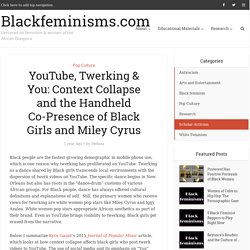
Twerking as a dance shared by Black girls transcends local environments with the dispersion of twerk videos on YouTube. The specific dance begins in New Orleans but also has roots in the “dance-drum” customs of various African groups. For Black people, dance has always offered cultural definitions and explanations of self. Still, the primary women who receive views for twerking are white women pop stars like Miley Cyrus and Iggy Azalea.
White women pop stars appropriate African aesthetics as part of their brand. Below I summarize Kyra Gaunt’s 2015 Journal of Popular Music article, which looks at how context collapse affects black girls who post twerk videos to YouTube. Sexual Politics of Black (Jamaican) feminism. In “Why We Get Off: Moving Towards a Black Feminist Politics of Pleasure,” Joan Morgan builds on Audre Lorde’s theory of the erotic, stating that “I want an erotic that demands space to be made for honest bodies that like to also fuck.”
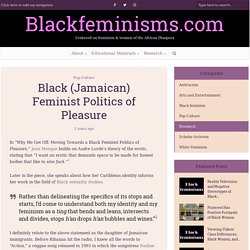
Later in the piece, she speaks about how her Caribbean identity informs her work in the field of Black sexuality studies: Rather than delineating the specifics of its stops and starts, I’d come to understand both my identity and my feminism as a ting that bends and leans, intersects and divides, stops h’an drops h’an bubbles and wines.” I definitely relate to the above statement as the daughter of Jamaican immigrants. Before Rihanna hit the radio, I knew all the words to “Action,” a reggae song released in 1993 in which the songstress Nadine Sutherland croons “I need some action/Tender satisfaction/My chemistry is flowing/Can you cause a chain reaction?”
Dancehall Queens: Erotic Revolutionaries of Jamaica. I have come across a constant theme while reading about Black women’s sexuality.
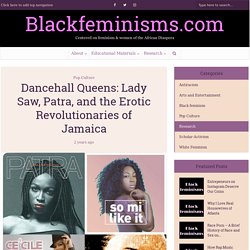
Most of the literature centers on how Black women have been made to be sex objects through white and male gaze. Few scholars write about the way Black women secure sexual agency in a male-dominated world. Shayne Lee is one of few scholars who have taken up the subject in his book Erotic Revolutionaries: Black Women, Sexuality, and Popular Culture. Spice - Tick Tak. Spice - Twerk. Professor Freedia Teaches How To Twerk. Entretien : "Twerk and Shout !", le twerk féministe. Depuis plus d’un an, Fannie Sosa et Poussy Draama organisent des cours de twerk dans toute la France.

Des ateliers pas comme les autres, où femmes (et hommes) de tous âges apprennent à bouger leurs fesses tout en s’initiant au féminisme. Bienvenue chez les activistes du bootyshake. Un twerkshop à Paris, en juin 2013. (Crédit image : Fanny Chassot) On leur parle de Miley Cyrus, elles nous rient au nez. Poussy Draama explique : Le twerk est un mouvement avant d’être une danse. Fannie Sosa complète : C'était avant tout une danse diasporique, une manière pour les populations qui le pratiquent de se rassembler, de se rebeller.
Big Freedia : «Le "bounce" ne parle que de libérer le corps» Il fait partie de ces artistes «showtime».

Spectaculaire, Big Freedia (né Freddie Ross) l’est assurément. En dix ans, il est devenu une figure queer du bounce de La Nouvelle-Orléans, genre très porté sur les fessiers et les cassures de hanches et ancêtre du twerk. Il est arrivé à Calvi pour décomplexer la ville corse, s’il en était besoin. L’esprit du bounce «C’est une histoire de tempo, de basses très puissantes. 06 makkay. What Does It Take To Be The ‘Dancehall Queen?’ – The Establishment. Through the transition from girl to woman, I loved my culture, but didn’t always feel like it loved me.
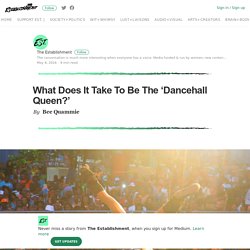
Ava DuVernay once tweeted, “To be a woman who loves hip hop at times is to be in love with your abuser. Because the music was and is that. And yet the culture is ours.” Growing up immersed in the music and culture of my Jamaican heritage, Ava’s words echoed my feelings toward dancehall. Misogyny, violence, and homophobia permeate both genres, with the male-dominated nature of each being highly prevalent. Originating in the inner city communities of Kingston, Jamaica in the late 1970s, dancehall music was a more brash version of the roots reggae style that preceded it. Dub poet Mutabaruka’s quote, “If 1970s reggae was red, green and gold, then in the next decade it was gold chains,” provides an insightful visual of the differences between the musical cousins, highlighting why some reggae purists bristled at the connection between “conscious” reggae and “slack” (vulgar) dancehall.
ART&FEMINISM // An Interview with Fannie Sosa: On Twerking and the Commons. Interview by Alison Hugill ; Monday, Jun. 22, 2015 Argentinian and Black-Brazilian artist, healer, and researcher Fannie Sosa has been traveling the world, both online and off, with her politically-informed and informative “twerkshops.”
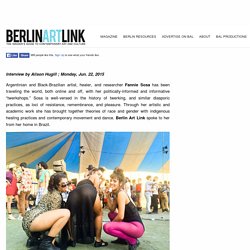
Sosa is well-versed in the history of twerking, and similar diasporic practices, as loci of resistance, remembrance, and pleasure. Through her artistic and academic work she has brought together theories of race and gender with indigenous healing practices and contemporary movement and dance. Berlin Art Link spoke to her from her home in Brazil. Portrait of Fannie Sosa (centre), Courtesy of the artist. Scene and heard: New Orleans Bounce and 'sissy rap' Two and a half years ago I travelled to New Orleans and spent a week meeting bounce DJs and going to bounce clubs.

It was there I discovered that the mass exodus caused by Hurricane Katrina was helping this largely localised and insular hip-hop scene spread to surrounding cities. Bounce has been around since the early 90s and is known for its repetitive, raw, jittery beats and repetitive, simple, often sexually explicit lyrics. COSMIC ASS Marilou Poncin : Fannie Sosa. Feminist Twerking. Is Twerking Sexist? Carlene The Dancehall Queen Impact on Jamaica and Dancehall.
Bruk Out! A Dancehall Queen Documentary -Long Teaser-